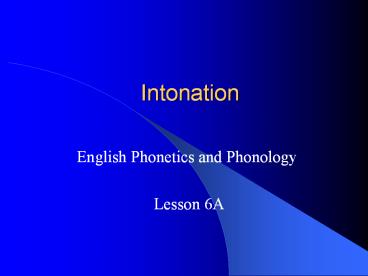Intonation - PowerPoint PPT Presentation
Title:
Intonation
Description:
Rise-Fall: emphatic statement. Level: boredom, disinterest. Fall: ... Rise-Fall: emphatic statement, irritation, command. Do I really have to clean my room? ... – PowerPoint PPT presentation
Number of Views:7052
Avg rating:3.0/5.0
Title: Intonation
1
Intonation
- English Phonetics and Phonology
- Lesson 6A
2
The functions of intonation
- Attitudinal function
- Accentual function
- Grammatical function
- Discourse function
3
Speech may be divided into tone units.Each tone
unit is composed of
- A tonic syllable (obbligatory)
- Optional elements which precede the tonic
syllable (pre-head, head) - Optional elements which follow the tonic syllable
(tail)
4
In short
- (pre-head) (head) tonic syllable (tail)
5
We will begin by looking at the tonic syllable,
it may follow one of these intonation patterns
- Fall
- Rise
- Fall-Rise
- Rise-Fall
- Level
6
Each of these may express particular attitudes
- Fall neutral statement
- Rise neutral question, doubt
- Fall-Rise surprise, scepticism
- Rise-Fall emphatic statement
- Level boredom, disinterest
7
Fall neutral statement, conclusion
- E.g. Have you seen Ann?
- Yes. (Falling intonation indicates I have
answered your question and do not intend to add
anything else)
8
Rise questioning, doubt, desire to continue
conversation
- E.g. Have you seen Ann lately?
- Yes (Rising intonation indicates I want to
continue the conversation, I am curious)
9
Rise-Fall emphatic statement, irritation,
command
- Do I really have to clean my room?
- Yes!
10
Fall-Rise surprise, scepticism
- Ann and Peter were on good terms at the party
- Oh yes?
11
Level boredom, lack of interest
- Can you remember Peter Jackson, the cost
consultant for our company in Taiwan? The other
day in the office I invited him for dinner, hell
be coming tomorrow. - Yes.
12
We shall begin by considering the fall here is a
tone unit solely composed of a tonic syllable
13
Things become more complicated when we add
syllables
14
In this case there are no stressed syllables
before the tonic I said is the pre-head
15
Here we have added a stressed syllable, told,
before the tonic, which is called the head.
Notice how the intonation rises from the pre-head.
16
Here we have added syllables after the tonic,
this is called the tail. Note how it tends to
follow the intonation pattern of the tonic.
17
This is obviously not the only possible
realisation of this sentence. If we put the main
stress on told, it changes the pattern
completely.
18
In a similar way a rising tonic syllable will
condition its tail here when is the tonic
syllable
19
Again when we come to complex tone we find the
tail following the tonic syllable for a
fall-rise the fall occurs on the tonic and the
rise at the end of the tail
20
No matter how many syllables there are in the
tail, the rise finishes on the last
21
While diagrams are immediate and clear, a more
practical system of symbols has been developed to
denote innotation
22
Stressed syllables in the head are noted with a
vertical tick
- I want to go to the dentists.
23
Stressed syllables in the tail are noted with a
dot
- I want to go to the dentists to.morrow
.morning
24
How to analyse a tone unit
- Identify the tonic (syllable) , i.e. the syllable
where there is strong movement and stress) - Are there any other stressed syllables before the
tonic? - - no the area before the tonic is called the
pre-head - - yes the area between the stressed syllable
and tonic is called the head and the area
before the stressed syllable is the pre-head - Are there any words after the tonic? If yes, this
is the tail
25
ESONERO LINGUA INGLESE 1 MODULOAB
- LUNEDI 15 DICEMBRE
- ORE 10 - A-L
- ORE 11 - MZ































